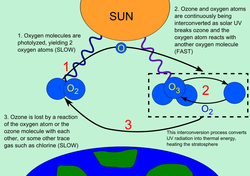ozone webquest
 Image from http://en.wikipedia.org/wiki/File:Ozone_cycle.svg
Image from http://en.wikipedia.org/wiki/File:Ozone_cycle.svg
Your task is to research;
You will be assigned one of the above research roles and will meet with a group that has researched the other three topics. Be sure to organize your findings, work efficiently, and keep in mind that you will serve as an expert on your topic to help others understand your area of focus.
The end product of your research should describe your findings help you present your information to your group and to the class. Each team will present their findings to the class.
Role
1: Atmospheric Scientist Your research will focus on the Earth’s atmosphere.
Your job is to research the overall structure (layers) & composition (% composition) of the atmosphere, the nature/types of UV radiation, & how ozone helps to absorbs UV radiation. Where is ozone helpful? Where is ozone harmful? You will work closely with the other members of your team in sharing ideas and data.
Role
2: Biologist Your research will focus on the effects of UV radiation on organisms & ecosystems.
Your job is to look at the effects of ultraviolet radiation on living tissues & biological productivity. What are mutations
& how are they related to UV radiation? What are the known health effects of UV exposure? How are producers such as phytoplankton affected? What effect will ozone depletion have on ecosystems? You will work closely with the other members of your team in sharing ideas and data.
Role
3: Chemist Your research will focus on the chemistry of ozone.
Your job is to look at the interaction between ozone and halogenated organic gases. What is ozone? What are halogenated gases? How and where do they react? Why is ozone classified as a replenishable resource? How is ozone’s replenishability affected by halogenated organic gases pollution? You will work closely with the other members of your team in sharing ideas and data.
Role
4: Product Specialist Your research will focus on the manufacture & release of ozone-depleting substances.
Your job is to find out which products are responsible for ozone depletion & research ways to reduce the
manufacture & release of ozone-depleting substances. Can refrigerants used in air conditioners/refrigerators be recycled? What are some of the best alternatives to ozone-depleting substances? What are examples of gas-blown
plastics? What are propellants & how do they contribute to ozone-depletion? What is methyl bromide (bromomethane?)
- the overall structure & composition of the atmosphere.
- the effects of ultraviolet radiation on living tissues & biological productivity.
- the interaction between ozone and halogenated organic gases.
- effective methods of reducing the manufacture & release of ozone-depleting substances.
You will be assigned one of the above research roles and will meet with a group that has researched the other three topics. Be sure to organize your findings, work efficiently, and keep in mind that you will serve as an expert on your topic to help others understand your area of focus.
The end product of your research should describe your findings help you present your information to your group and to the class. Each team will present their findings to the class.
Role
1: Atmospheric Scientist Your research will focus on the Earth’s atmosphere.
Your job is to research the overall structure (layers) & composition (% composition) of the atmosphere, the nature/types of UV radiation, & how ozone helps to absorbs UV radiation. Where is ozone helpful? Where is ozone harmful? You will work closely with the other members of your team in sharing ideas and data.
Role
2: Biologist Your research will focus on the effects of UV radiation on organisms & ecosystems.
Your job is to look at the effects of ultraviolet radiation on living tissues & biological productivity. What are mutations
& how are they related to UV radiation? What are the known health effects of UV exposure? How are producers such as phytoplankton affected? What effect will ozone depletion have on ecosystems? You will work closely with the other members of your team in sharing ideas and data.
Role
3: Chemist Your research will focus on the chemistry of ozone.
Your job is to look at the interaction between ozone and halogenated organic gases. What is ozone? What are halogenated gases? How and where do they react? Why is ozone classified as a replenishable resource? How is ozone’s replenishability affected by halogenated organic gases pollution? You will work closely with the other members of your team in sharing ideas and data.
Role
4: Product Specialist Your research will focus on the manufacture & release of ozone-depleting substances.
Your job is to find out which products are responsible for ozone depletion & research ways to reduce the
manufacture & release of ozone-depleting substances. Can refrigerants used in air conditioners/refrigerators be recycled? What are some of the best alternatives to ozone-depleting substances? What are examples of gas-blown
plastics? What are propellants & how do they contribute to ozone-depletion? What is methyl bromide (bromomethane?)
